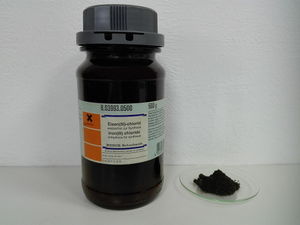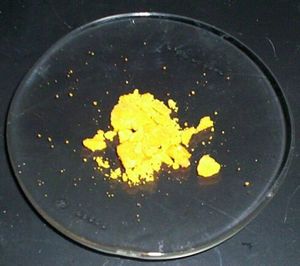Iron(III) chloride
 Anhydrous FeCl3 and original bottle
| |
 Hydrated crystals of ferric chloride
| |
| Names | |
|---|---|
| IUPAC name
Iron(III) chloride
| |
| Other names
Ferric chloride
Flores martis Iron trichloride Molysite | |
| Properties | |
| FeCl3 | |
| Molar mass | 162.204 g/mol (anhydrous) 270.295 g/mol (hexahydrate) |
| Appearance | Black hygroscopic solid (anhydrous) Yellow hygroscopic solid (hydrated) |
| Odor | Slight acidic |
| Density | 2.90 g/cm3 (anhydrous) 1.82 g/cm3 (hexahydrate) |
| Melting point | 307.6 °C (585.7 °F; 580.8 K) (anhydrous) 37 °C (99 °F; 310 K) (hexahydrate) |
| Boiling point | 316 °C (601 °F; 589 K) (anhydrous, decomposes) 280 °C (536 °F; 553 K) (hexahydrate, decomposes) |
| 91.2 g/100 ml (anh. or hexahydrate, 25 °C) | |
| Hazards | |
| Safety data sheet | Sigma-Aldrich (anhydrous) Sigma-Aldrich (hexahydrate) |
| Flash point | Non-flammable |
| Related compounds | |
| Related compounds
|
Iron(II) chloride |
| Except where otherwise noted, data are given for materials in their standard state (at 25 °C [77 °F], 100 kPa). | |
| Infobox references | |
Iron(III) chloride, also known as ferric chloride, is a compound of iron and chlorine with the formula FeCl3. It is a moderately strong Lewis acid and many of its applications exploit this property. It normally exists as a hexahydrate salt. When heated or anhydrous, it tends to hydrolyze, producing hydrogen chloride gas. It is a popular catalyst for organic synthesis, and the most common printed circuit board etchant (though there are better ones).
Contents
[hide]Properties
Physical properties
Iron(III) chloride is a black deliquescent solid when anhydrous and yellow solid as the common hexahydrate form, but undergoes many different color changes when the anhydrous form is viewed under different light sources at different angles. Aqueous solutions tend to be dark reddish-brown in color. The material resembles aluminium chloride due to its covalent character, and has a narrow liquid range when anhydrous, ranging from only 306 to 315 °C, and dimerizes as a vapor.
Chemical properties
As a strong Lewis acid, iron(III) chloride is corrosive and readily forms adducts with Lewis bases, such as triphenylphosphine oxide. It will also dissolve in methanol and ethanol quite readily. Ferric chloride is also highly soluble in acetone. Strong heating will convert the hexahydrate form, or the anhydrous form in the presence of water, to iron(III) oxychloride and hydrogen chloride, and the anhydrous form to iron(II) chloride and chlorine gas. It is a mild oxidizing agent. FeCl3 is capable of reacting with copper yielding copper(II) chloride and ferrous chloride.
Iron(III) chloride hydrates cannot be dehydrated to anhydrous, because it decomposes to iron(III) oxychloride and hydrogen chloride, or iron hydroxide and hydrogen chloride.
When solutions of iron(III) chloride are presented with metallic iron, they are slowly reduced back to iron(II) chloride, which can be reverted back to iron(III) chloride by the addition of more hydrochloric acid and oxygen or hydrogen peroxide.
Iron (III) chloride produces colorful insoluble compounds with several common reagents. These reactions can be used to determine the presence of trivalent iron; they can also be used to produce pigments and inks.
- With tannic acid: black
- With potassium ferrocyanide: blue (Prussian blue)
- With potassium thiocyanate: red (also used as "fake blood"), soluble but very deep-colored
Availability
Iron(III) chloride is a popular printed circuit board (PCB) etchant. It is available as a solution at many electronics store, such as RadioShack. The solid forms (both anhydrous and hydrated) can be purchased from chemical suppliers.
Preparation
Iron (III) chloride hydrate may be produced by adding steel wool (which is relatively pure iron) to a mixture of hydrogen peroxide and hydrochloric acid, and then filtering off the carbon.
- Fe + 3 HCl + [O] → FeCl3 + H2O
Boiling the solution at low pH will yield hydrated crystals of ferric chloride.[1] Anhydrous iron (III) chloride can be produced by combining pure iron metal to dry chlorine gas at high temperature, in a tube furnace, at high temperature.[2]
- 2 Fe + 3 Cl2 → 2 FeCl3
Solutions of green iron(II) chloride slowly oxidize in air or on heating to form iron(III) chloride, provided there are excess chloride ions in solution. This is a somewhat reversible reaction, as the addition of more iron to ferric chloride solutions reverts it back to iron(II) chloride.
Projects
- Detecting phenol compounds
- Etch PCBs
- Separate gold from electronic fingers and pins
- Etching widmanstätten patterns into meteorites
- Making iron complexes (Prussian blue e.g.)
- Producing ferrocene
- Producing ferrofluid[3]
Handling
Safety
Iron(III) chloride is corrosive and will stain many surfaces dark brown. If it touches the skin, it will turn it brown-yellowish and may cause burns if the pH is low enough. It is also extremely irritant to sensitive tissues. FeCl3 stains on clothes are impossible to remove.
Anhydrous ferric chloride will dissolve exothermically in water, during which small particles will be scattered in air and will land on nearby items and people, staining everything it touches. To prevent this, you should perform this process in a plastic sink or in a plastic container, preferably covered.
Storage
Ferric chloride should be stored in closed plastic or glass bottles, at a low pH.
Disposal
Ferric chloride can be neutralized with calcium hydroxide. This yields calcium chloride and iron oxide/hydroxide, which can be safely disposed of.
References
- Jump up ↑ https://www.youtube.com/watch?v=43Xsh9J7S-g
- Jump up ↑ https://www.thevespiary.org/library/Files_Uploaded_by_Users/no1uno/pdf/Toolkit/Acquisition/Chemical/Catalysts/FC.Acylation/Tarr.Preparation.Anhydrous.Iron.III.Chloride.Inorgsyn.Vol.3.pdf
- Jump up ↑ https://www.youtube.com/watch?v=LlQw9dfexBQ